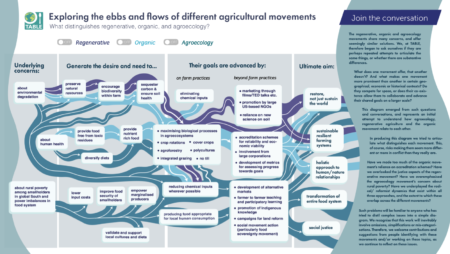- Two guides to making good presentations. For what it’s worth, here’s my take: fewer words.
- The latest on taro leaf blight in Samoa, from an Indigenous perspective. Not a presentation in sight.
- Agroforestry in the Solomon Islands involves 132 species. Probably including taro.
- The case for agroecology from the Global Alliance for the Future of Food. You could also see the above.
- Or, we could tweak photosynthesis.
Nibbles: Maize landraces, Indian plantain, Indigenous conservation, Slow Food, Design a tomato, Saffron in Vermont
- A Mexican entrepreneur and a Pawnee Keeper of the Seed try to save maize landraces in their different ways.
- Indian farmer tries to save plantain varieties.
- Indigenous conservation will save conservation.
- Alice Walters cannot save the food system. But why not let her try?
- None of the above of them would understand the concept of designing a perfect tomato.
- Saffron is the perfect spice.
Brainfood: IK, CWR, AnGR valuation double, Open cryo hardware, Seed pathogens, Perennial grains, Tropical forages, Tree breeding, Resurrection, Arabica origins, Fragaria, CIP sweetpotato
- Contributions of Indigenous Knowledge to ecological and evolutionary understanding. The importance of IK is considerable for PGRFA conservation and use too, of course, and the injunction to “enter into a thoughtful social contract with IK holders, foremost working toward partnered research that benefits the communities, governments, and nations of Indigenous peoples” goes double.
- Harnessing Crop Wild Diversity for Climate Change Adaptation.. …needs open data. Genomic data, that is, rather than IK. I wonder if there’s quid pro quo here.
- Genetic Identity, Diversity, and Population Structure of CIP’s Sweetpotato (I. batatas) Germplasm Collection. An entire collection of about 6000 accessions genotyped to reveal 4 ancestral populations, some duplication within and between genebanks, plus possible mistakes in labelling. Ah, data!
- Information use and its effects on the valuation of agricultural genetic resources. Giving the public more data may increase the support for animal genetic resources conservation. But what kind of data? Read on…
- Consumers’ knowledge and perceptions of endangered livestock breeds: How wording influences conservation efforts. Focus on the nice taste rather than the rarity or endangerment of breeds, as it turns out. Accentuate the positive?
- The emerging role of open technologies for community-based improvement of cryopreservation and quality management for repository development in aquatic species. Hardware can be open too.
- Longevity of Plant Pathogens in Dry Agricultural Seeds during 30 Years of Storage. Clean your seeds, genebanks.
- Sustainable agriculture through perennial grains: Wheat, rice, maize, and other species. A review. Promises, promises…
- Tapping Into the Environmental Co-benefits of Improved Tropical Forages for an Agroecological Transformation of Livestock Production Systems. Location, location, location.
- ‘Systems approach’ plant breeding illustrated by trees. Link up different plant breeding approaches in fun ways rather than doubling down on any single one.
- A pragmatic and prudent consensus on the resurrection of extinct plant species using herbarium specimens. I must say I would not have been so prudent.
- Validating South Sudan as a Center of Origin for Coffea arabica: Implications for Conservation and Coffee Crop Improvement. No time for prudence here.
- Diversification, spread, and admixture of octoploid strawberry in the Western Hemisphere. Yes, that’s all very interesting, but tell me more about that Hawaiian strawberry.
Nibbles: OSGC, Satellites, IK, Craft beer, Livestock & CC
- Organic Seed Growers Conference, February 4–11, 2022. Don’t miss it.
- Mapping biodiversity from space. Agrobiodiversity next? I wish.
- How to cite Indigenous knowledge. Including in germplasm databases? I wish.
- An old Czech barley variety from an Austrian genebank makes a comeback in craft brewing. I dunno though, I need to look into this a bit more.
- Demonizing livestock is unjust. But will probably continue.
Confused about woke agricultural movements?
Not to worry, TABLE is here with a handy cheat sheet.
Now you can tell your agroecology from your regenerative agriculture from your organic agriculture.
I have two questions though. Why not also have “conventional” agriculture in there? And, is it really that important to know these differences?
